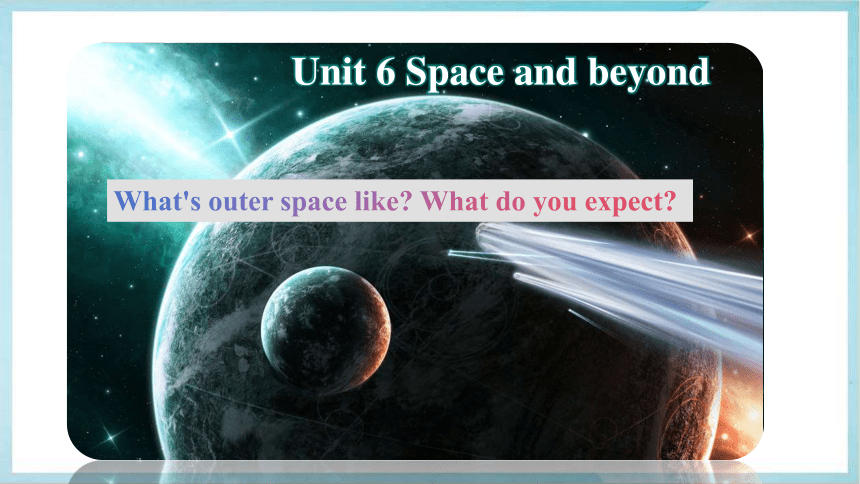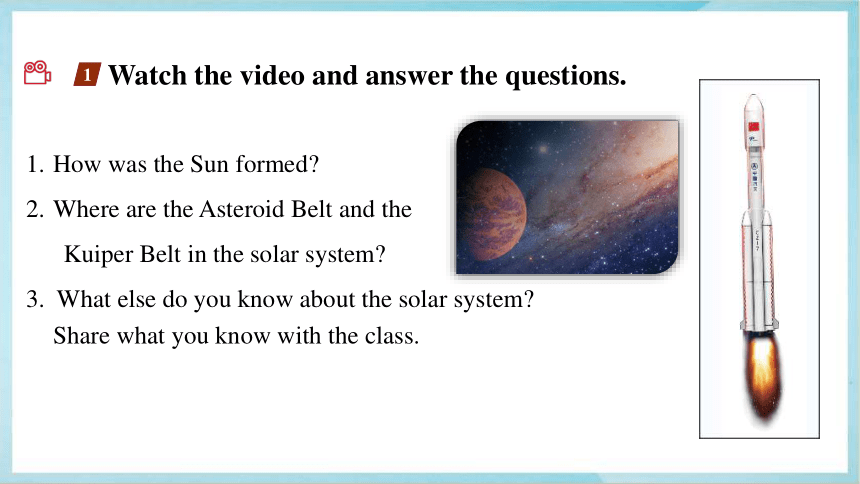Unit 6 Space and beyond Starting out 课件(共25张,内嵌视频) 2024-2025学年高二英语外研版(2019)选择性必修4
文档属性
| 名称 | Unit 6 Space and beyond Starting out 课件(共25张,内嵌视频) 2024-2025学年高二英语外研版(2019)选择性必修4 |  | |
| 格式 | pptx | ||
| 文件大小 | 29.5MB | ||
| 资源类型 | 教案 | ||
| 版本资源 | 外研版(2019) | ||
| 科目 | 英语 | ||
| 更新时间 | 2025-04-22 16:46:54 | ||
图片预览









文档简介
(共25张PPT)
Unit 6 Starting out
Space and beyond
太空和宇宙之外
导读课件
To learn more words and expressions about different meanings.
Try to grasp the real meanings of the phrases in the passage.
To learn to use the phrases to make sentences.
Write some interesting English passages using the words and phrases we have learned.
Learning objectives
Words and expressions
become accustomed to 习惯于(做)某事
82
* notion n. 概念;观点;看法 82
* hazardous adj. 危险的,不安全的 82
unexceptional adj. 平常的 82
* shuttle n. 航天飞机 82
the space shuttle 航天飞机 82
* excursion n. (有特定目的的)短途出行
83
* rekindle v. 重新激起,重新唤起 83
* tragically adv. 悲惨地,不幸地 83
* instantaneously adv. 瞬间地 83
shadow n. 坏影响,阴影 83
cast a shadow on 给……蒙上阴影 83
scream v. (因疼痛、惊恐、兴奋等)尖声大叫 84
suspend v. 暂停,中止 84
crew n. (飞机上的)全体机组人员 84
* simulated adj. 模仿的,模拟的,仿真的
88
* simulator n. (用于人员训练的)模拟装置,模拟器 89
* lifelike adj. (图画、模型等)生动的,逼真的 89
submit v. 提交 89
awesome adj. 很好的,了不起的 89
单词 自 测
1. adj.习惯的
2. n.概念;观点;看法
3. adj.危险的,不安全的
4. n.航天飞机
5. n.(有特定目的的)短途出行
6. adv.悲惨地,不幸地
7. adv.瞬间地
8. n.坏影响,阴影
9. v.暂停,中止
10. n.(飞机上的)全体机组人员
accustomed
notion
hazardous
shuttle
excursion
tragically
instantaneously
shadow
suspend
crew
1. adj.平常的 → adj.例外的;独特的①
2. v.重新激起,重新唤起 → v.鼓舞;点燃②
unexceptional
exceptional
rekindle
kindle
拓展自测
掌握规律 巧记单词
① un-(不;非)+exceptional adj.例外的;独特的→unexceptional adj.平常的 例如:unfinished adj.未完成的 undoubted adj.无疑的
unhealthy adj.不健康的 unaccessible adj.难接近的
② re-(再;又)+kindle v.鼓舞;点燃→rekindle v.重新激起,重新唤起
例如:reset v.重新设置;复位 rearrange v.重新安排
rebuild v.重建 reallocate v.重新分配
Unit 6 Space and beyond
What's outer space like What do you expect
How was the Sun formed
Where are the Asteroid Belt and the
Kuiper Belt in the solar system
3. What else do you know about the solar system Share what you know with the class.
Watch the video and answer the questions.
1
Watch the video and answer the questions.
1
The Asteroid Belt
The Kuiper Belt
The Oort Cloud
The Solar System
小行星带
太阳系
柯伊伯带
奥尔特云
The Solar System
Where do planets come from The answer lies in the stars, or at least in the birthplaces of the stars, which are vast clouds of gas and dust, scattered through space. Our Sun was born in such a place, more than four and a half billion years ago. This is how it happened. Attracted by its gravity, enough gas and dust pulls itself together into a disc. Inside the disc, solid pieces come together - each one growing as it takes in more material and eats up smaller neighbors. The winners will become the planets. Meanwhile, building pressure heats up the center of the disc to one million degrees - hot enough for nuclear reactions to begin. In a flash, the young Sun turns itself on, blowing the disc away, starting an infant
solar system.
Our solar system can be divided into three distinct parts made of rock, gas and ice. As this astronomer explains:
“The scale model of our solar system that I've set up showing the different distances of the planets illustrates these parts very clearly. For example, here orbiting close to the Sun are four small rocky planets: Mercury, Venus, Earth, Mars. Too small at birth to hold on to the lightest elements, these planets represent rare concentrations of minerals in a universe that is 98% hydrogen and helium gas.”
视频脚本
The Solar System
Between the last rocky planet, Mars and the first of the gas planets, Jupiter, lies a rocky wasteland called “the Asteroid Belt”. And beyond this, “A new kind of solar system, this one made of gas, takes over. Planets here are composed mainly of hydrogen and helium. They're enormous. They're widely spaced. They command vast systems of rings and moons, as though each one were almost an imitation of the Sun itself. Jupiter is the largest and nearest, then comes Saturn, Uranus and Neptune.”
And just like the Asteroid Belt marks the boundary between the rocky and gas planets, astronomers now believe a similar region called “the Kuiper Belt”exists just beyond the orbit of Neptune, the last of the gas planets. Because it's so far from the Sun's warmth, anything in this Belt is rich in ice and frozen gas.
One thousand times farther away than the Kuiper Belt, hundreds of billions of comets drift at the edge of the solar system. Occasionally, the Sun's gravity pulls some comets closer, allowing us to see them and study them, letting scientists learn more about the beginnings of our solar system.
视频脚本
太阳系
行星从何而来? 答案就在恒星中,或者至少在恒星的诞生地,这些地方是散布在太空中的巨大的气体和尘埃云。 45亿年前,我们的太阳就是在这样一个地方诞生的。 事情是这样发生的。 在它的引力的吸引下,足够多的气体和尘埃将自己拉到一起形成一个圆盘。 在圆盘内部,固体碎片聚集在一起,每一个都在吸收更多的物质并吞噬更小的邻居。 赢家将成为行星。 与此同时,积聚的压力将圆盘中心加热到100万度——足以引发核反应。 刹那间,年轻的太阳启动了自己,把圆盘吹走,开始了一个婴儿太阳系。
我们的太阳系可以分为三个不同的部分,由岩石、气体和冰组成。 这位天文学家解释道:
“我建立的太阳系比例模型显示了行星之间的不同距离,非常清楚地说明了这些部分。 例如,这里有四颗小的岩石行星绕着太阳运行:水星、金星、地球、火星。 这些行星出生时太小,无法容纳最轻的元素,它们代表了宇宙中98%的氢气和氦气中罕见的矿物质浓度。”
视频脚本
太阳系
在最后一颗岩石行星火星和第一颗气体行星木星之间,有一片岩石荒地,被称为“小行星带”。 除此之外,“一种新的太阳系,这种由气体组成的太阳系,将会接管。 这里的行星主要由氢和氦组成。 它们是巨大的。 它们的间隔很宽。 他们控制着巨大的光环和卫星系统,好像每一个都几乎是太阳本身的模仿。 木星是最大和最近的,然后是土星、天王星和海王星。”
就像小行星带标志着岩石行星和气体行星之间的界限一样,天文学家现在相信,在最后一颗气体行星海王星的轨道之外,也存在着一个类似的区域,叫做“柯伊伯带”。 因为远离太阳的温暖,这个带里的任何东西都富含冰和冰冻气体。
比柯伊伯带远一千倍的地方,有数千亿颗彗星漂浮在太阳系的边缘。 偶尔,太阳的引力会把一些彗星拉得更近,让我们能够看到并研究它们,让科学家们更多地了解太阳系的起源。
视频脚本
Watch the video and answer the questions.
1
How was the Sun formed
2. Where are the Asteroid Belt and the Kuiper Belt in the solar system
First, enough gas and dust pulled together to make a disc where the planets were formed. Then, building pressure heated up the center of the disc to one million degrees, and a nuclear reaction began, which formed the Sun.
The Asteroid Belt lies between Mars and Jupiter .
The Kuiper Belt exists just beyond the orbit of Neptune.
Watch the video and answer the questions.
1
3. What else do you know about the solar system Share what you know with the class.
The solar system is a complex and diverse place with many fascinating features. Beyond the planets, there are regions like the “Asteroid Belt”(小行星带) between Mars and Jupiter, filled with rocky debris, and the ”Kuiper Belt”(柯伊伯带) beyond Neptune, which contains icy bodies and dwarf planets like Pluto. Far beyond the Kuiper Belt lies the ”Oort Cloud”(奥尔特云), a distant region believed to be the source of long-period ets, when pulled closer to the Sun, develop glowing tails and provide clues about the early solar system. Additionally, gas giants like Jupiter and Saturn have extensive systems of rings and moons, making them almost like miniature solar systems themselves. These regions and objects help scientists understand the formation and evolution of our solar system.
太阳系是一个复杂而多样的地方,充满了许多迷人的特征。除了行星之外,还有一些区域,比如火星和木星之间的“小行星带”,那里充满了岩石碎片;还有海王星之外的“柯伊伯带”,那里包含冰质天体和矮行星,如冥王星。在柯伊伯带之外更远的地方是“奥尔特云”,这是一个遥远的区域,被认为是长周期彗星的来源。当彗星被太阳引力拉近时,会形成发光的彗尾,并为我们提供关于太阳系早期形成的线索。此外,像木星和土星这样的气体巨行星拥有广泛的环系统和卫星系统,使它们几乎像是迷你太阳系。这些区域和天体帮助科学家们理解太阳系的形成和演化过程。
Which of these spacecraft had a human on board when launched
What are the recent events in China’s space programme Add them to the timeline.
What do you know about China’s future plans for space exploration
Look at the timeline and answer the questions.
2
24 April 1970:
China launched Dongfanghong1, becoming the fifth country to send a satellite into orbit.
15 October 2003:
Shenzhou V blasted off from the Jiuquan Satellite Launch Centre, sending China`s first astronaut into space.
2 December 2013:
China launched its third unmanned lunar probe, Chang`e 3, which made a soft landing on the Moon and then released a lunar rover.
15 September 2016:
China launched its second space lab, Tiangong-2 into orbit. It is a key element of the nation`s plan for permanent space station.
Look at the timeline and answer the questions.
2
Which of these spacecraft had a human on board
when launched
The spacecraft that had a human on board when launched was “Shenzhou V”, which sent China's first astronaut into space on 16 October 2003.
Look at the timeline and answer the questions.
2
Look at the timeline and answer the questions.
2
2. What are the recent events in China’s space programme
Add them to the timeline.
Additional recent events (not in the original timeline
but relevant):
23 July 2020: China sent Tianwen 1 by Changzheng V to explore Mars millions of kilometres away.
April 2021: China launched the first module of its permanent space station, Tianhe.
24 April 1970:
China launched Dongfanghong1, becoming the fifth country to send a satellite into orbit.
15 October 2003:
Shenzhou V blasted off from the Jiuquan Satellite Launch Centre, sending China`s first astronaut into space.
2 December 2013:
China launched its third unmanned lunar probe, Chang`e 3, which made a soft landing on the Moon and then released a lunar rover.
15 September 2016:
China launched its second space lab, Tiangong-2 into orbit. It is a key element of the nation`s plan for permanent space station.
23 July 2020:
China sent Tianwen 1 by Changzheng V to explore Mars millions of kilometres away.
April 2021:
China launched the first module of its permanent space station, Tianhe.
Look at the timeline and answer the questions.
2
3. What do you know about China’s future plans for
space exploration
China plans to establish a permanent space station.
The first module of the space station, Tianhe, was successfully launched in April 2021.
China aims to complete the full construction of the space station by 2025.
Other future plans may include further lunar and Mars exploration missions, as well as advancements in space technology and research.
Summary of Major Breakthroughs in China's Space Program until 2025:
1970: China launched Dongfanghong-1, becoming the fifth country to send a satellite into orbit.
2003: Shenzhou V successfully sent China's first astronaut into space.
2013: Chang'e 3, China's third unmanned lunar probe, made a soft landing on the Moon and released a lunar rover.
2016: China launched Tiangong-2, a key element of the nation's plan for a permanent space station.
2020: Tianwen 1, launched by Changzheng V, began exploring Mars.
2021: The first module of China's permanent space station, Tianhe, was launched.
2025 (planned): Completion of the full construction of China's permanent
space station.
These milestones demonstrate China's rapid progress and ambitions in space exploration.
根据所学外太空知识,结合近些年中国在航天事业的发展与成就,谈谈你对“探索宇宙奥秘”这一主题的思考,要谈出民族自豪感和对深化探索宇宙奥秘的兴趣。词数不超过150词。
Homework
Exploring the Mysteries of the Universe
---China's Aerospace Achievements Inspire National Pride
In recent years, China's aerospace industry has witnessed remarkable development, igniting a spark of national pride within me. From the successful implementation of the manned space program to the completion of the Tiangong space station, these achievements demonstrate China's determination and capability in exploring the universe.
Exploring the mysteries of the universe is not just a scientific endeavor; it's a journey of human curiosity and aspiration. China's lunar and Mars exploration missions, such as Chang'e-6 and Tianwen-1, have not only expanded our understanding of the cosmos but also showcased China's contribution to global scientific progress.
These accomplishments fill me with a profound interest in deepening our exploration of the universe. They remind me that every step we take in space exploration is a step closer to understanding our origins and potential future homes. As China continues to advance in aerospace, my national pride grows, fueled by the knowledge that we are actively participating in uncovering the secrets of the universe.
One Sample
Exploring the Mysteries of the Universe
---China's Aerospace Achievements Inspire National Pride
Exploring the mysteries of the universe has always been a dream for humanity, and China's recent achievements in space exploration have made this dream more tangible. From launching the first Chinese astronaut into space with Shenzhou V to the successful landing of Tianwen-1 on Mars, China has shown remarkable progress. These milestones not only enhance our understanding of the cosmos but also fill us with national pride.
The journey to the Moon with Chang'e missions and the establishment of the Tiangong space station highlight China's commitment to deep space exploration. These achievements inspire a sense of wonder and curiosity about the universe. They remind us that the quest for knowledge knows no bounds and that every discovery brings us closer to understanding our place in the cosmos.
As we look to the future, the excitement for further exploration grows. The potential for new discoveries and the advancement of technology fuel our passion for uncovering the secrets of the universe. China's contributions to space exploration are a testament to human ingenuity and the enduring spirit of discovery.
Another Sample
Unit 6 Starting out
Space and beyond
太空和宇宙之外
导读课件
To learn more words and expressions about different meanings.
Try to grasp the real meanings of the phrases in the passage.
To learn to use the phrases to make sentences.
Write some interesting English passages using the words and phrases we have learned.
Learning objectives
Words and expressions
become accustomed to 习惯于(做)某事
82
* notion n. 概念;观点;看法 82
* hazardous adj. 危险的,不安全的 82
unexceptional adj. 平常的 82
* shuttle n. 航天飞机 82
the space shuttle 航天飞机 82
* excursion n. (有特定目的的)短途出行
83
* rekindle v. 重新激起,重新唤起 83
* tragically adv. 悲惨地,不幸地 83
* instantaneously adv. 瞬间地 83
shadow n. 坏影响,阴影 83
cast a shadow on 给……蒙上阴影 83
scream v. (因疼痛、惊恐、兴奋等)尖声大叫 84
suspend v. 暂停,中止 84
crew n. (飞机上的)全体机组人员 84
* simulated adj. 模仿的,模拟的,仿真的
88
* simulator n. (用于人员训练的)模拟装置,模拟器 89
* lifelike adj. (图画、模型等)生动的,逼真的 89
submit v. 提交 89
awesome adj. 很好的,了不起的 89
单词 自 测
1. adj.习惯的
2. n.概念;观点;看法
3. adj.危险的,不安全的
4. n.航天飞机
5. n.(有特定目的的)短途出行
6. adv.悲惨地,不幸地
7. adv.瞬间地
8. n.坏影响,阴影
9. v.暂停,中止
10. n.(飞机上的)全体机组人员
accustomed
notion
hazardous
shuttle
excursion
tragically
instantaneously
shadow
suspend
crew
1. adj.平常的 → adj.例外的;独特的①
2. v.重新激起,重新唤起 → v.鼓舞;点燃②
unexceptional
exceptional
rekindle
kindle
拓展自测
掌握规律 巧记单词
① un-(不;非)+exceptional adj.例外的;独特的→unexceptional adj.平常的 例如:unfinished adj.未完成的 undoubted adj.无疑的
unhealthy adj.不健康的 unaccessible adj.难接近的
② re-(再;又)+kindle v.鼓舞;点燃→rekindle v.重新激起,重新唤起
例如:reset v.重新设置;复位 rearrange v.重新安排
rebuild v.重建 reallocate v.重新分配
Unit 6 Space and beyond
What's outer space like What do you expect
How was the Sun formed
Where are the Asteroid Belt and the
Kuiper Belt in the solar system
3. What else do you know about the solar system Share what you know with the class.
Watch the video and answer the questions.
1
Watch the video and answer the questions.
1
The Asteroid Belt
The Kuiper Belt
The Oort Cloud
The Solar System
小行星带
太阳系
柯伊伯带
奥尔特云
The Solar System
Where do planets come from The answer lies in the stars, or at least in the birthplaces of the stars, which are vast clouds of gas and dust, scattered through space. Our Sun was born in such a place, more than four and a half billion years ago. This is how it happened. Attracted by its gravity, enough gas and dust pulls itself together into a disc. Inside the disc, solid pieces come together - each one growing as it takes in more material and eats up smaller neighbors. The winners will become the planets. Meanwhile, building pressure heats up the center of the disc to one million degrees - hot enough for nuclear reactions to begin. In a flash, the young Sun turns itself on, blowing the disc away, starting an infant
solar system.
Our solar system can be divided into three distinct parts made of rock, gas and ice. As this astronomer explains:
“The scale model of our solar system that I've set up showing the different distances of the planets illustrates these parts very clearly. For example, here orbiting close to the Sun are four small rocky planets: Mercury, Venus, Earth, Mars. Too small at birth to hold on to the lightest elements, these planets represent rare concentrations of minerals in a universe that is 98% hydrogen and helium gas.”
视频脚本
The Solar System
Between the last rocky planet, Mars and the first of the gas planets, Jupiter, lies a rocky wasteland called “the Asteroid Belt”. And beyond this, “A new kind of solar system, this one made of gas, takes over. Planets here are composed mainly of hydrogen and helium. They're enormous. They're widely spaced. They command vast systems of rings and moons, as though each one were almost an imitation of the Sun itself. Jupiter is the largest and nearest, then comes Saturn, Uranus and Neptune.”
And just like the Asteroid Belt marks the boundary between the rocky and gas planets, astronomers now believe a similar region called “the Kuiper Belt”exists just beyond the orbit of Neptune, the last of the gas planets. Because it's so far from the Sun's warmth, anything in this Belt is rich in ice and frozen gas.
One thousand times farther away than the Kuiper Belt, hundreds of billions of comets drift at the edge of the solar system. Occasionally, the Sun's gravity pulls some comets closer, allowing us to see them and study them, letting scientists learn more about the beginnings of our solar system.
视频脚本
太阳系
行星从何而来? 答案就在恒星中,或者至少在恒星的诞生地,这些地方是散布在太空中的巨大的气体和尘埃云。 45亿年前,我们的太阳就是在这样一个地方诞生的。 事情是这样发生的。 在它的引力的吸引下,足够多的气体和尘埃将自己拉到一起形成一个圆盘。 在圆盘内部,固体碎片聚集在一起,每一个都在吸收更多的物质并吞噬更小的邻居。 赢家将成为行星。 与此同时,积聚的压力将圆盘中心加热到100万度——足以引发核反应。 刹那间,年轻的太阳启动了自己,把圆盘吹走,开始了一个婴儿太阳系。
我们的太阳系可以分为三个不同的部分,由岩石、气体和冰组成。 这位天文学家解释道:
“我建立的太阳系比例模型显示了行星之间的不同距离,非常清楚地说明了这些部分。 例如,这里有四颗小的岩石行星绕着太阳运行:水星、金星、地球、火星。 这些行星出生时太小,无法容纳最轻的元素,它们代表了宇宙中98%的氢气和氦气中罕见的矿物质浓度。”
视频脚本
太阳系
在最后一颗岩石行星火星和第一颗气体行星木星之间,有一片岩石荒地,被称为“小行星带”。 除此之外,“一种新的太阳系,这种由气体组成的太阳系,将会接管。 这里的行星主要由氢和氦组成。 它们是巨大的。 它们的间隔很宽。 他们控制着巨大的光环和卫星系统,好像每一个都几乎是太阳本身的模仿。 木星是最大和最近的,然后是土星、天王星和海王星。”
就像小行星带标志着岩石行星和气体行星之间的界限一样,天文学家现在相信,在最后一颗气体行星海王星的轨道之外,也存在着一个类似的区域,叫做“柯伊伯带”。 因为远离太阳的温暖,这个带里的任何东西都富含冰和冰冻气体。
比柯伊伯带远一千倍的地方,有数千亿颗彗星漂浮在太阳系的边缘。 偶尔,太阳的引力会把一些彗星拉得更近,让我们能够看到并研究它们,让科学家们更多地了解太阳系的起源。
视频脚本
Watch the video and answer the questions.
1
How was the Sun formed
2. Where are the Asteroid Belt and the Kuiper Belt in the solar system
First, enough gas and dust pulled together to make a disc where the planets were formed. Then, building pressure heated up the center of the disc to one million degrees, and a nuclear reaction began, which formed the Sun.
The Asteroid Belt lies between Mars and Jupiter .
The Kuiper Belt exists just beyond the orbit of Neptune.
Watch the video and answer the questions.
1
3. What else do you know about the solar system Share what you know with the class.
The solar system is a complex and diverse place with many fascinating features. Beyond the planets, there are regions like the “Asteroid Belt”(小行星带) between Mars and Jupiter, filled with rocky debris, and the ”Kuiper Belt”(柯伊伯带) beyond Neptune, which contains icy bodies and dwarf planets like Pluto. Far beyond the Kuiper Belt lies the ”Oort Cloud”(奥尔特云), a distant region believed to be the source of long-period ets, when pulled closer to the Sun, develop glowing tails and provide clues about the early solar system. Additionally, gas giants like Jupiter and Saturn have extensive systems of rings and moons, making them almost like miniature solar systems themselves. These regions and objects help scientists understand the formation and evolution of our solar system.
太阳系是一个复杂而多样的地方,充满了许多迷人的特征。除了行星之外,还有一些区域,比如火星和木星之间的“小行星带”,那里充满了岩石碎片;还有海王星之外的“柯伊伯带”,那里包含冰质天体和矮行星,如冥王星。在柯伊伯带之外更远的地方是“奥尔特云”,这是一个遥远的区域,被认为是长周期彗星的来源。当彗星被太阳引力拉近时,会形成发光的彗尾,并为我们提供关于太阳系早期形成的线索。此外,像木星和土星这样的气体巨行星拥有广泛的环系统和卫星系统,使它们几乎像是迷你太阳系。这些区域和天体帮助科学家们理解太阳系的形成和演化过程。
Which of these spacecraft had a human on board when launched
What are the recent events in China’s space programme Add them to the timeline.
What do you know about China’s future plans for space exploration
Look at the timeline and answer the questions.
2
24 April 1970:
China launched Dongfanghong1, becoming the fifth country to send a satellite into orbit.
15 October 2003:
Shenzhou V blasted off from the Jiuquan Satellite Launch Centre, sending China`s first astronaut into space.
2 December 2013:
China launched its third unmanned lunar probe, Chang`e 3, which made a soft landing on the Moon and then released a lunar rover.
15 September 2016:
China launched its second space lab, Tiangong-2 into orbit. It is a key element of the nation`s plan for permanent space station.
Look at the timeline and answer the questions.
2
Which of these spacecraft had a human on board
when launched
The spacecraft that had a human on board when launched was “Shenzhou V”, which sent China's first astronaut into space on 16 October 2003.
Look at the timeline and answer the questions.
2
Look at the timeline and answer the questions.
2
2. What are the recent events in China’s space programme
Add them to the timeline.
Additional recent events (not in the original timeline
but relevant):
23 July 2020: China sent Tianwen 1 by Changzheng V to explore Mars millions of kilometres away.
April 2021: China launched the first module of its permanent space station, Tianhe.
24 April 1970:
China launched Dongfanghong1, becoming the fifth country to send a satellite into orbit.
15 October 2003:
Shenzhou V blasted off from the Jiuquan Satellite Launch Centre, sending China`s first astronaut into space.
2 December 2013:
China launched its third unmanned lunar probe, Chang`e 3, which made a soft landing on the Moon and then released a lunar rover.
15 September 2016:
China launched its second space lab, Tiangong-2 into orbit. It is a key element of the nation`s plan for permanent space station.
23 July 2020:
China sent Tianwen 1 by Changzheng V to explore Mars millions of kilometres away.
April 2021:
China launched the first module of its permanent space station, Tianhe.
Look at the timeline and answer the questions.
2
3. What do you know about China’s future plans for
space exploration
China plans to establish a permanent space station.
The first module of the space station, Tianhe, was successfully launched in April 2021.
China aims to complete the full construction of the space station by 2025.
Other future plans may include further lunar and Mars exploration missions, as well as advancements in space technology and research.
Summary of Major Breakthroughs in China's Space Program until 2025:
1970: China launched Dongfanghong-1, becoming the fifth country to send a satellite into orbit.
2003: Shenzhou V successfully sent China's first astronaut into space.
2013: Chang'e 3, China's third unmanned lunar probe, made a soft landing on the Moon and released a lunar rover.
2016: China launched Tiangong-2, a key element of the nation's plan for a permanent space station.
2020: Tianwen 1, launched by Changzheng V, began exploring Mars.
2021: The first module of China's permanent space station, Tianhe, was launched.
2025 (planned): Completion of the full construction of China's permanent
space station.
These milestones demonstrate China's rapid progress and ambitions in space exploration.
根据所学外太空知识,结合近些年中国在航天事业的发展与成就,谈谈你对“探索宇宙奥秘”这一主题的思考,要谈出民族自豪感和对深化探索宇宙奥秘的兴趣。词数不超过150词。
Homework
Exploring the Mysteries of the Universe
---China's Aerospace Achievements Inspire National Pride
In recent years, China's aerospace industry has witnessed remarkable development, igniting a spark of national pride within me. From the successful implementation of the manned space program to the completion of the Tiangong space station, these achievements demonstrate China's determination and capability in exploring the universe.
Exploring the mysteries of the universe is not just a scientific endeavor; it's a journey of human curiosity and aspiration. China's lunar and Mars exploration missions, such as Chang'e-6 and Tianwen-1, have not only expanded our understanding of the cosmos but also showcased China's contribution to global scientific progress.
These accomplishments fill me with a profound interest in deepening our exploration of the universe. They remind me that every step we take in space exploration is a step closer to understanding our origins and potential future homes. As China continues to advance in aerospace, my national pride grows, fueled by the knowledge that we are actively participating in uncovering the secrets of the universe.
One Sample
Exploring the Mysteries of the Universe
---China's Aerospace Achievements Inspire National Pride
Exploring the mysteries of the universe has always been a dream for humanity, and China's recent achievements in space exploration have made this dream more tangible. From launching the first Chinese astronaut into space with Shenzhou V to the successful landing of Tianwen-1 on Mars, China has shown remarkable progress. These milestones not only enhance our understanding of the cosmos but also fill us with national pride.
The journey to the Moon with Chang'e missions and the establishment of the Tiangong space station highlight China's commitment to deep space exploration. These achievements inspire a sense of wonder and curiosity about the universe. They remind us that the quest for knowledge knows no bounds and that every discovery brings us closer to understanding our place in the cosmos.
As we look to the future, the excitement for further exploration grows. The potential for new discoveries and the advancement of technology fuel our passion for uncovering the secrets of the universe. China's contributions to space exploration are a testament to human ingenuity and the enduring spirit of discovery.
Another Sample
